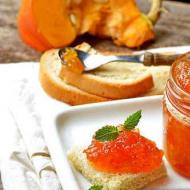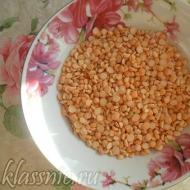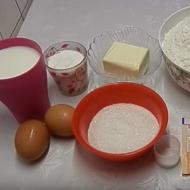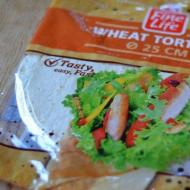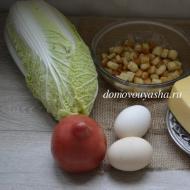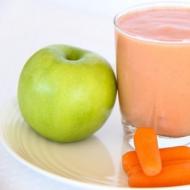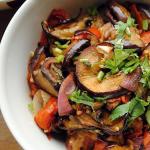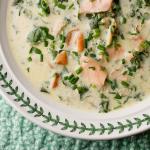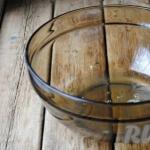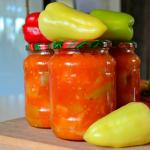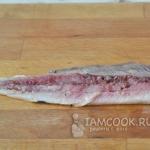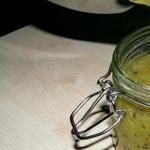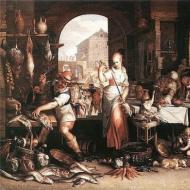
Easter cake recipe from Anastasia Skripkina. Easter cake that always works out Easter cake recipe from Nastya Skripkina



The dough in the Easter cake turns out wonderful, light and airy.
minus - the dough is so active that it continues to rise even when
cooking, as a result, my Easter cakes turned out to be in the form of mushrooms (with
cap on a stem).
I borrowed the recipe from Anastasia Skripkina on the 7say website.
500 ml. milk
11 gr. dry yeast (or 50 g pressed)
1 kg. flour
6 eggs
200 gr. butter (or butter margarine)
250 gr. Sahara
300 gr. raisins
1 tsp vanilla sugar
For the glaze:
1 egg white
1 tsp lemon juice
100 gr. powdered sugar
Milk
heat until steamed, dissolve yeast in nm, add 300
gr. flour, stir, cover with a towel and put in a warm place for 30
minutes.
Separate the whites from the yolks.
Grind the yolks with sugar.
Beat the whites until foamy with a pinch of salt.
Pour the yolks into the suitable dough, stir, add softened butter (do not melt), then add the whites.
Add the remaining flour (sifted through a sieve), knead well (the dough should not stick to your hands).
Let the dough rise in a warm place (about 50-60 minutes).
At this time, steam the raisins. Rinse the raisins, pour boiling water over them, leave for 10 minutes, drain the water, dry the raisins.
After the dough has risen, add the prepared raisins and stir well again.
Forms
for Easter cakes, grease with oil, put dough in them (1/3 volume), again
place in a warm place to rise (no more than 30 minutes). Preheat
oven to 180 degrees and bake small cakes for about 25
minutes, large ones - a little more.
As soon as the cake is browned on top, you can open the oven and check the readiness with a skewer (until the skewer is dry).
Prepare the glaze.
For this we need 1 well-chilled egg white, 1 tsp. lemon juice and 100 gr. powdered sugar.
Beat the whites into a foam, add powdered sugar, beat until thick. Add lemon juice and beat a little more.
Brush the cooled Easter cakes with glaze (preferably with a pastry brush), decorate and refrigerate until the glaze hardens.
Instructions
- Anastasia Skripkina's Easter cake begins by heating the milk a little (but not too much - a little warmer than room temperature is enough) and dissolving the yeast in it. After this, add a little sugar. Stir well.
- Add half a kilogram of flour to the milk mixture. Add in small portions and mix.

- Place the dough in a warm place in a room where there are no drafts. You can also do the following: place the container with the dough in a basin or any other larger container, which is filled with hot water (but not boiling water!).

- The dough will double in volume in about an hour. Depending on the room temperature, it may take a little longer. Mix the dough, cover the container with a towel and leave in a warm place for another half hour.

- While the dough is rising, take chicken eggs and separate the whites from the yolks. Mix the yolks with the remaining sugar, add vanilla sugar. Mash well in a separate bowl. If you do this by hand with a spoon, it will take longer. You can use a mixer.

- Add the egg mixture to the suitable dough and mix again. After this, add softened butter in portions (one hour before cooking, remove the product from the refrigerator) and continue stirring. After this, add the whites to the dough and mix thoroughly again.

- After this, you can start kneading the dough. To do this, add flour into the mixture in portions, stir and observe the consistency. The dough should not be too stiff or sticky to your hands. Cover the container with the dough with a lid and place it in a warm place for half an hour.

- While the dough is rising, soak the raisins in hot water. Leave it until the water cools down. After this, place on a paper towel and dry.

- Add raisins to the risen dough. Mix it thoroughly to evenly distribute the raisins throughout the entire volume. Let the dough rise again for another hour. Once the dough has doubled in volume, knead it thoroughly again. Grease your hands with vegetable oil and knead the dough well.

- Distribute the dough into molds pre-greased with vegetable oil. Fill the forms one-third full. Place the dough in the molds in a warm place for half an hour. Wait for the dough to rise. After this, bake the cakes in a well-heated oven at 180 degrees. To prevent the cakes from burning, you can pour a little water on the bottom tray.

- While the cakes are baking, you can prepare the frosting for decoration. To do this, beat two egg whites with sugar using a mixer. Beat for about 5-7 minutes. First, add half a teaspoon of lemon juice to the whites, beat for about two minutes, then add sugar and beat for at least another five minutes. In this case, you will get a thick, white and fluffy mass with which you will decorate Easter cakes.

04/09/2015 16:55 TsDI, Pskov
There must be Easter cake on the Easter table. This pastry is an indispensable attribute of the holiday. Of course, you can buy Easter cake at any grocery store in Pskov without any problems. At the same time, nothing prevents you from baking Easter cake yourself. Believe me, it's easy!
There is an opinion that you only need to cook Easter cake in a good mood, then it will turn out perfect. And the key to success is proven recipes. TsDI has collected several worthy recipes for Easter cakes and Easter from famous media chefs.
Recipes from Daria Dontsova
“Please note that you will have to spend money on this recipe, because the Easter cake will require high-quality products. In any cookbook you will now find many Easter cake recipes. But I don’t really like those that suggest taking twenty eggs and a kilogram of butter. The dough turns out to be too fatty, so I cook the Easter cake the way my grandmother taught me,” Dontsova writes in her cookbook.

photo livejournal.com
Easter cake recipe
For the test
: 400 g flour, 100 g sugar, 160 g butter, 4 eggs, 100 g milk, 80 g raisins, 2 g salt, 20 g yeast, vanillin.
For syrup
: 60 g sugar, 20 g wine, 45 g water.
For fondant
: 90 g sugar, 25 g water, 30 g jam, vinegar.
For the dough, mix a third of the flour with warm water in a 1:1 ratio. Dilute the yeast separately in a small amount of water, add it to the dough and leave to ferment at 30 °C for 80-90 minutes. Or, if you use dry yeast, mix it with flour and put it into the dough. Grind butter, sugar, salt, vanillin until smooth. Stirring, add eggs, sorted and washed raisins. Put all this into the dough, mix, add the rest of the flour and mix thoroughly. Place the kneaded dough into greased cylindrical molds so that it occupies no more than a quarter of the mold, and leave to rise in a warm place. As soon as the dough increases in volume by 2–2.5 times, bake the cakes at 180–200 °C for 60–70 minutes. Cool the finished cake, remove it from the mold, and let it stand for at least 8 hours. After this, it can be soaked in syrup, the top greased with jam and sprinkled with powdered sugar or glazed with fudge sugar.
Preparation of syrup for impregnation. Dissolve sugar in water, bring to a boil, skimming off the foam, cool to 40 °C and, stirring, pour in wine.
Making fudge. Add boiling water to the sugar and bring to a boil, stirring all the time. After this, add 1-2 drops of vinegar and continue cooking until tender. Determine the readiness of the syrup as follows: take a little syrup on a spoon, cool, and if after that you can roll a ball, then the syrup is ready. Pour the finished syrup onto an enamel tray and mix thoroughly with a spatula until it turns white.
You can use ready-made glaze from a jar or buy a semi-finished product in a bag. The top of the Easter cakes can be sprinkled with multi-colored decorations - now the store shelves are full of a variety of “stars”, “circles”, “hearts” intended for sprinkling finished dough products.
Recipes from Yulia Vysotskaya
Yulia Vysotskaya, in her program “Eating at Home,” introduced viewers to several recipes for Easter cakes. We invite you to try some of them.

photo edimdoma.ru
Easter cake recipe No. 1
To prepare Easter cake according to this recipe from Yulia Vysotskaya, you will need the following ingredients:
Flour - 500 g
- sugar - 275 g
- butter - 250 g
- eggs - 6 pcs.
- lemon juice - 2 tbsp. l.
- sea salt - 15 g
- dry yeast - 10 g
First, let's prepare the dough. To do this, dilute the yeast in 50 ml of warm water, add 25 ml of flour and mix with a wooden spoon. Cover the container with a lid and place in a warm place.
Sift the remaining flour through a sieve, add 75 g of sugar and salt and mix with a wooden spoon. Add the dough to the flour and mix until smooth. While stirring gently, beat in five eggs one at a time. Add softened butter and knead the dough thoroughly with your hands. Cover the bowl with the dough and put it in the refrigerator for 8-10 hours.
3-4 hours before baking, remove the chilled dough from the refrigerator and place it in a warm place. Just before baking, place the dough into molds and brush the top with beaten egg. Preheat the oven to 200 degrees and bake the cakes for 10 minutes. Then reduce the temperature to 150 degrees and bake until done (about half an hour for large Easter cakes, about 10 minutes for small ones).
To prepare the glaze, melt the remaining sugar in a water bath with lemon juice. Grease the finished cakes with glaze. Instead of glaze, you can use whipped egg whites with sugar for greasing.
Easter cake recipe No. 2
Raisins, nuts, and candied fruits are often added to Easter cakes. Why not make a cake with almonds and raisins? So, stock up on the following products:
Premium wheat flour - 1 kg
- milk - 600 ml
- butter - 210 g
- sugar - 200 g
- almonds - 200 g
- seedless raisins - 200 g
- yolks - 5 pcs.
- egg - 1 pc.
- lemon - 1 pc.
- fresh yeast - 20 g
- cardamom - 6-8 grains
- sea salt - 2 tsp.
Sift the flour through a sieve. Heat the milk until it is warm but not hot. We dilute the yeast in a small amount of warm milk. When they are completely dispersed, combine them with the remaining milk.
Gradually pour the sifted flour into the milk, add salt and a pinch of sugar, and knead the dough. Cover the container with the dough with a clean towel and place in a warm place for an hour.
While the dough is rising, grind the almonds into homogeneous crumbs using a blender. Grind the cardamom in a mortar and grate the zest of one lemon on a fine grater. Beat the yolks with the remaining sugar. Without stopping whisking, add 200 g of softened butter and almost all the almonds, as well as lemon zest and cardamom.
Combine the butter-almond mixture with the dough, knead thoroughly, cover again with a towel and put in a warm place for another hour until the dough rises. Wash the raisins, dry them, add them to the dough and knead one last time.
Grease the baking dish with the remaining butter. We make several round layers of dough of different diameters, 2-3 cm thick. Sprinkle each layer with flour, place them in the mold on top of each other in the form of a pyramid (from larger layer to smaller) and put the mold with the dough in a warm place for another half an hour.
Preheat the oven to 180 degrees. Brush the risen cake with beaten egg, sprinkle with the remaining almonds and bake for 40-50 minutes.
Recipes from Anastasia Skripkina
Nastya has several recipes for Easter cakes; we have chosen the two most popular ones, which, judging by the comments, always turn out perfectly.

Classic Easter cake recipe
Ingredients:
- 500 ml milk
- 11 g dry yeast (or 50-60 g raw yeast)
- 1-1.3 kg flour
- 6 eggs
- 250-300 g sugar
- 300 g raisins
- 1 tsp. vanilla sugar.
Glaze:
- 2 squirrels
- 100 g sugar
Preparation
From the specified amount of ingredients, you get 3 Easter cakes 11 cm high and 17 cm wide and 6 small Easter cakes 7 cm high and 6 cm wide.
Heat the milk a little (so that it is slightly warm), dissolve the yeast in it. Add 500 g of flour, stir well. Place in a warm place and cover with a towel. The dough should double in size (this will take about 30 minutes).
Separate the whites from the yolks. Grind the yolks with sugar and vanilla sugar. Beat the whites with a pinch of salt until foamy. Add the yolks to the suitable dough and mix. Then add softened butter and stir.
Add whites, mix. Add the remaining flour (you may need a little more or less flour, it depends on the quality of the flour), knead the dough. The dough must be kneaded well, it should not be stiff and should not stick to your hands. Put the dough back in a warm place. Let the dough rise well (this will take 50-60 minutes). Soak the raisins in warm water for 10-15 minutes, then drain all the water.
Add raisins to the risen dough, mix and put the dough back in a warm place. The dough should rise well. Grease the mold with oil and place the dough at 1/3 of the height of the mold. Cover with film or towel. Let the dough rise again in its form. Place in an oven preheated to 100 degrees and bake for 10 minutes. Then increase the temperature to 180 degrees and bake until done.
To check the readiness of the cake, pierce it with a match (or a toothpick); if it is dry, the cake is ready. Preparing the glaze.
Beat the whites with a pinch of salt until foamy. Add sugar, beat until stiff peaks form.
Grease the finished hot cakes with glaze and sprinkle with confectionery topping or decorate with candied fruits.
Saffron Easter cake
Ingredients:
- 250 ml milk
- 7-11 g dry yeast (or 50-60 g fresh yeast)
- 150 g sugar
- 2 tsp. vanilla sugar
- 5 yolks
- a pinch of saffron stigmas or 1/3 tsp. ground saffron
- 200 g butter or margarine
- 650-700 g flour
- 50 g raisins
- 50 g nuts (I have almonds)
- 50 g candied fruits
glaze:
- 2 squirrels
- 100 g sugar
Thanks to saffron, the cakes are very fragrant and bright. The most important secret of a successful Easter cake is to cook it in a good mood, then it will turn out fluffy, tall and very tasty. From the specified amount of ingredients you get 2 Easter cakes 11 cm high and 17 cm wide.
Grind the saffron stigmas in a mortar. Pour 3 tbsp. hot water (ground saffron also pour 3 tablespoons of hot water).
Leave for 10-15 minutes. Heat the milk a little (so that it is slightly warm), add yeast and 1 tsp. Sahara.
Add 200 g of flour, mix, cover with a towel, and place in a warm place. The dough should double in size (this will take about 30 minutes). Grind the yolks with sugar and vanilla sugar. Add the yolks to the suitable mixture and mix.
Add saffron (along with water). Add softened butter, stir. Add 450-500 g of flour, knead the dough. The dough must be kneaded well, it should not be stiff and should not stick to your hands. Put the dough back in a warm place. Let the dough rise well (this will take 50-60 minutes).
The dough should rise well. Chop the nuts. If the candied fruits are large, they should be cut into small pieces. Add raisins, nuts, candied fruits to the dough. Mix well.
Place the dough in a warm place again and let it rise well. Grease the mold with oil and place the dough at 1/3 of the height of the mold. Let the dough rise again in its form.
Then place in an oven preheated to 180 degrees and bake for 35-40 minutes (cooking time depends on the size of the mold). If the top of the cake starts to burn, cover it with foil. Grease the finished hot cakes with glaze (beat the whites with sugar) and sprinkle with confectionery topping or decorate with candied fruits.
Nika Belotserkovskaya
According to Nika, Easter cake is the same cupcake, but with small reservations. “I really like this option. Here, by and large, the main hemorrhoids are only in “waiting,” but put a timer in your pocket and calmly go about your business,” she writes in her cookbook.

photo cityspb.ru
For the dough: 150 grams of flour (good quality bread), 250 ml of warm milk, 1 packet of dry instant yeast (I had 11 grams), a spoonful of sugar.
For the dough: 400 grams of flour, 3 eggs, 100 grams of butter, zest of one medium lemon, a pinch of salt, 150 grams of sugar, a mixture of nuts, candied fruits, dried fruits (about a glass). You can add vanilla if you wish.
Divide the eggs into 2 eggs + yolk. Leave the white to grease the cake.
Important: all ingredients must be at room temperature.
Mix flour, milk, sugar and yeast well for the dough, cover with film and leave for an hour. It should rise well. Next, grate the zest on a fine grater, being careful not to touch the white part of the lemon. Mix it with sugar, butter and eggs. Very, very good - a few minutes, using a mixer.
Mix the flour with salt and place it on the table in a heap, gradually adding the dough, and start kneading. The dough should not stick to your hands - it is necessary for the gluten to “develop” in it. As a result, the dough should become quite elastic and stretchy, almost like chewing gum.
Add a mixture of nuts and dried fruits. And, also, if you plan to prepare dough with raisins, rinse the raisins in hot water and sprinkle lightly with flour, then the raisins will be distributed evenly in the dough.
Make a ball out of the dough. Spread a large bowl with oil, cover with film and forget about it for another hour and a half.
This is how it will increase in volume - approximately twice. Again, place it on a floured surface and knead it a little. Next, wrap it in a napkin and set it aside.
We prepare the mold - grease it with butter and put our dough there, press it down lightly and forget about it again for an hour. Don't forget to cover the pan with film. The dough should rise to about double in size again.
Whip the egg white with a spoonful of water and carefully and evenly spread on the surface of the cake. Place the mold in an oven preheated to 180 degrees. Bake until done for exactly one hour. And after about 25 minutes, the top of your head will surely be baked; immediately cover it well with foil, otherwise it will burn.
And the time may vary plus or minus five to ten minutes, depending on the activity of your oven. Check. Pierce it with a long stick - it should remain dry.
We take it out, carefully run a long knife along the edges inside the mold so that it does not stick, and let it cool a little. Remove and cool completely on a wire rack. You can sprinkle it with powdered sugar or even pour chocolate glaze over it.
Another holiday treat is Easter. Its main component is pureed cottage cheese, to which butter, sour cream or cream, eggs (or just yolks) and sugar are added. You can add raisins, raisins, candied fruits, jam syrup, lemon zest, cinnamon to Easter - it all depends on your taste. Cottage cheese must be exclusively natural, fresh, homogeneous, medium or high fat content.

Sweet Easter recipe from Daria Dontsova
Boil 1.8 liters of cream, skim off the foam, add a spoonful of sour cream to the cream and boil again. Remove the risen foam again, add another spoonful of sour cream to the cream and continue cooking over low heat, skimming off the foam, until the whey comes off. Then pour everything into a napkin, let the whey drain, put the cottage cheese in a bowl, add 1 glass of granulated sugar and, at your discretion, vanillin or cardamom or lemon zest, grind thoroughly and put in the prepared form, under pressure, for several hours in a cool place . To prevent the cream from burning during the preparation of Easter, it is stirred continuously or, even better, steamed.
Easter recipe with chocolate from Daria Dontsova
Grind 1.2 kg of dry cottage cheese, pureed through a sieve, with 400 g of butter so that a homogeneous mass is formed. Add 0.2 liters of cream, 200 g of grated chocolate, 2 cups of granulated sugar, and a little vanilla.
Grind until smooth. Fill out the prepared form, apply pressure and place in a cool place for a day.
Custard Easter recipe from Daria Dontsova
Beat 10 yolks into a saucepan, add 2-3 cups of granulated sugar, 0.3 liters of warm cream, a little vanilla and, stirring continuously, cook over moderate heat until thickened, but do not boil. Then pour into a porcelain or ceramic bowl, season the hot mixture with 400 g of butter, cut into pieces, and cool. Gradually combine 1.6 kg of dry cottage cheese, mashed through a sieve, with the cooled mixture to form a smooth mass. Place it in the prepared form, put pressure on it and leave it in a cool place for 10–12 hours.
Easter recipe from Julia Vysotskaya
Ingredients:
500 g dry fat cottage cheese
- 300 g powdered sugar
- 100 g butter
- 100 ml heavy cream
- a handful of raisins
- a handful of dried apricots
- 30 g pistachios
- 2 eggs
- 50 ml cognac.
Soak raisins in cognac. Rub the cottage cheese through a sieve, add softened butter, mix thoroughly, combine with cream. Beat the eggs with powdered sugar, add to the curd mass and stir. Cut dried apricots into small pieces. Squeeze the raisins and add to the cottage cheese along with dried apricots and pistachios (leave a few pistachios). Line a special Easter pan or a bowl with holes with gauze and add the curd mass. Lay the edges of the gauze crosswise. Place the bowl with Easter in a saucepan of a smaller diameter so that the liquid can drain, and put something heavy on top. After 4 hours, when the liquid has drained, place the Easter in the refrigerator for at least 12 hours. Decorate the finished Easter with the remaining pistachios.
Easter recipe from Anastasia Skripkina
Ingredients:
-
1 kg cottage cheese (9-20%)
-
200 g butter
-
5 eggs
-
200 g sugar
-
vanilla stick or 1 tsp. vanilla sugar
-
400 ml cream (10-20%)
-
100 g nuts (any to taste)
-
100 g raisins
-
100 g candied fruits
This tender, fragrant Easter will decorate the Easter table, assures Anastasia Skripkina. It's easy to prepare, but it turns out very, very tasty. For the filling you can use any nuts, candied fruits, dried fruits, to taste. From the specified amount of ingredients you get 2 Easter eggs, 10 cm high and 12 cm in diameter.
Rub the cottage cheese through a sieve or pass through a meat grinder. Add softened butter, stir. Cut the vanilla stick, remove the seeds, beat the eggs with sugar, add cream, mix.
Add vanilla seeds (if you are using vanilla sugar, add it at this stage too). Place the mixture over medium heat, bring to a boil and cook, stirring constantly, until the mixture begins to thicken.
Then cool the mixture a little. Finely chop the nuts. If the candied fruits are large, they need to be cut.
Mix cottage cheese, candied fruits, nuts, raisins (the raisins must first be washed and dried). Add the egg mixture to the cottage cheese and mix. Cover the bean bag with gauze folded in 2-3 layers, the edges of the gauze should hang down.
Place the curd mixture in a bowl. If there is no bean box, you can use a new flower pot or colander. Wrap the edges. Place the mold in a plate or bowl, as the whey will drain, and place a weight on top.
Place the mold along with the load in the refrigerator for 12 hours. Then remove the edges of the gauze, turn the mold over, remove the gauze. Decorate Easter to taste.
Recipes for Easter cake and Easter cottage cheese are passed down from generation to generation in many homes. So the author of cookbooks and TV shows, Anna Lyudkovskaya, has her own history of these Easter dishes - and her own proven recipes, which are included in her book “Our Favorite Food. Stories and Recipes.” We suggest preparing Easter cake from yeast dough with candied fruits, as well as raw Easter cake from cottage cheese.
Easter cake
We have an old notebook covered in fabric at home. My great-grandmother ran it and wrote down her income and expenses, useful tips and recipes. Every year on the eve of Easter, now my grandmother takes this book out of the cupboard and, looking at the yellowed pages covered in pencil, bakes Easter cakes. This tradition was not interrupted even in the atheistic Soviet years, although no one went to church services anymore and no one was going to explain to me the meaning of the holiday. I had to figure it out myself. For me, this is the standard - the dense, heavy Easter cake of my great-grandmother Lidia Dmitrievna Krasnova.
You will need:
- 570 g flour
- 20 g fresh or 10 g dry yeast
- 140 ml warm milk
- 3 eggs
- 150 g butter
- 1 cup of sugar
- 1 teaspoon vanilla sugar
- 75 g raisins
- 50 g of any candied fruits
- 50 g almond petals
- ½ teaspoon salt
For the glaze:
- 1 protein
- ½ cup powdered sugar
- 1 tablespoon lemon juice
- Dissolve fresh yeast and 1 teaspoon of sugar in a third of a glass of warm water. Let the yeast foam. Mix milk and yeast in a bowl. Sift a quarter of the flour into the liquid, mix with a mixer, then add another quarter, stirring. Cover the bowl with film and place the dough in a warm place (in a blanket near the radiator) for 30-60 minutes. If you are using dry yeast, then add it along with the first batch of flour and increase the volume of milk by a third of a glass.
- Separate the whites from the yolks, leaving one yolk for brushing. Grind the yolks with sugar and vanilla sugar, and beat the whites until a fluffy foam forms.
- Add salt, yolks, butter to the dough and mix. Then add the remaining flour and beaten egg whites. Knead the dough. It should not be very thick and easily come off the sides of the bowl. Wrap in a blanket and place in a warm place for another 1-2 hours.
- When the dough has doubled in size, add raisins, diced candied fruits and almonds. Take tall pans, cover the bottom and sides with baking paper. Place the prepared dough into the molds, cover with a kitchen towel and let the cakes rise. The dough should double in size again. Brush the tops of future Easter cakes with egg yolk. Place in a cold oven, turn it on to 100 degrees and hold for 10 minutes. Then increase the temperature to 150 and bake the cakes for 1 hour. Check readiness with a wooden skewer: if the skewer is dry and the dough does not stick to it, then the cake is ready.
- For the glaze, beat the egg whites until stiff, add the powdered sugar, beat, then pour in the lemon juice and beat for another ten seconds. Cover the cake with glaze and let it dry.
Classic wet Easter
Curd mass with raisins is Easter, which is usually prepared for the holiday of the Resurrection of Christ. Preparing Easter is very simple - combine all the ingredients, put it in a mold and put it under pressure. The main thing is to get hold of the form. I still have a family wooden bean box, eaten by bugs, shrunk so much that I have to support the walls with matches, but it has so much history and charm that I voluntarily suffer every spring. Wooden and silicone bean boxes are now being sold in stores and church shops.
There are two types of Easter - raw, like mine, and boiled, when the ingredients are heated on the stove. Culinary historians note that they began to prepare Easter for the holiday of the Resurrection of Christ only in the 18th century. But numerous pies with cottage cheese and cheesecakes have been on the festive table from time immemorial - it was necessary to somehow use the cottage cheese accumulated during Lent.

You will need:
- 1.6 kg of good low-fat cottage cheese
- 150 g butter
- 3 eggs
- 1 can of condensed milk
- 2 tablespoons vanilla sugar
- 1 teaspoon salt
- 2 handfuls of light, seedless raisins
- Pass the cottage cheese and butter through a meat grinder or beat in a blender. Lightly beat the eggs with a fork, add salt, vanilla sugar and combine with cottage cheese. Then add condensed milk, washed raisins and mix well. A food processor will do this job in a minute.
- Cover the bean box with slightly damp gauze, lay out the curd mass, cover the top with gauze and place under pressure. To do this, place an inverted saucer on top of the Easter, and on it a heavy stone or a jar of water. Place the Easter in a plate into which the whey will drain. Drain the whey from time to time to keep the bottom layer of the Easter dry.
- Place Easter in the refrigerator for 12 hours, during which time excess liquid should drain. Before serving, remove the pan and cheesecloth and let the Easter stand at room temperature for 5-10 minutes.
Comment on the article "Kulich and Easter - according to ancient recipes"
More on the topic “How to bake yeast cake for Easter, a recipe for raw Easter from cottage cheese”:
Kulich and Easter - according to old recipes. Recipe for Easter cake and Easter from cottage cheese - for the Resurrection of Christ. How to cook Easter cake on sourdough. Easter cakes are usually baked from sponge dough. Easter recipes are not only about Easter cakes and ways to color eggs.
Kulich and Easter - according to old recipes. Recipes for Easter cake and cottage cheese Easter in many homes are passed down from generation to generation. We have an old notebook covered in fabric at home.
I made it according to the recipe from say7, with sour cream, it differs radically from the Pokhlebkin recipe. [link-1] Then OOOlga gave a link to a cottage cheese cake from the “cook” website. [link-1] This one interested me, I thought I’d try it.
Kulich and Easter - according to old recipes. We suggest making Easter cakes from yeast dough with candied fruits, as well as raw ones from cottage cheese. Mix milk and yeast in a bowl. Sift a quarter of the flour into the liquid, mix with a mixer, then add another quarter...
I lost the Easter cake recipe. - gatherings. Cooking. Culinary recipes, help and advice on preparing dishes, holiday menus and Good afternoon, last year I prepared incredibly delicious Easter cakes using a recipe from the conference. I only remember that it was very fatty, there was butter, cottage cheese and/or...
Kulich and Easter. Bakery. Cooking. Culinary recipes, help and advice on preparing dishes, holiday menus and entertaining guests, food selection. In order for the whites to whip into a fluffy foam, they must be very cold. Kulich and Easter - according to old recipes.
Recipe for Easter cake and Easter from cottage cheese - for the Resurrection of Christ. How to cook Easter cake and Easter. Next time I’ll try to make Easter cake, I’ve already written down the recipe.. Comment on the article “Kulich and Easter - according to old recipes.”
Kulich and Easter - according to old recipes. Recipes for Easter cake and Easter cottage cheese are passed down from generation to generation in many homes. For me, this is the standard - the dense, heavy Easter cake of my great-grandmother Lidia Dmitrievna Krasnova.
Recipe: Easter cake. Announcements from the Cookbook. Cooking. Culinary recipes, help and advice on preparing dishes, holiday menus and entertaining guests, selection of Easter cake, Easter and other sweets recipes for the Easter table. About Easter and Easter cakes. My recipe!.
Easter, however. Give me some advice! 1. Please share your favorite Easter recipe. Last year I cooked according to Yulia Vysotskaya’s recipe, and it turned out so tasteless! 2. And one more thing - where do you buy ready-made Easter cake so that it’s really delicious, huh?
Kulich and Easter - according to old recipes. Recipe for Easter cake and Easter from cottage cheese - for the Resurrection of Christ. How to bake Easter cake and cook Easter: detailed recipes.
help save the Easter cake!. Bakery. Cooking. Culinary recipes, help and advice on preparing dishes, holiday menus and entertaining guests, choosing the dough - yes, but the Easter cake turns out loose or airy, Easter cakes should not be like that, it is a dense product that is difficult to digest...
Who baked according to Molokhovets? Teach you how to cook! Cooking. Culinary recipes, help and advice on cooking, holiday menu and reception Who baked according to Molokhovets? And what is generally considered a “classic” Easter cake? Or maybe someone has a link to the recipe from the Pest lying around?
Recipe: Easter cake. To begin with, let's make a dough by mixing yeast, milk and a couple of glasses of flour. Carefully remove the finished products and place them on a plate. It’s delicious and beautiful, our Easter cake!
Easter recipes: pie instead of Easter cake and Easter with chocolate. Easter 2016: recipe for Easter cottage cheese and Easter pie with bulgur. Kulich and Easter - according to old recipes. Classic wet Easter. Curd mass with raisins - this is Easter, which is customary...
Thanks for the Easter cake recipes, but how does anyone make Easter? I've been making "raw Easter" for several years now. the problem is the final Kulich and Easter - according to old recipes. If you are using dry yeast, then add it along with the first batch of flour and increase by a third...
Easter cake. Girls, please tell me the recipes (but only those you personally tested!) for Easter cake. In order for the whites to whip into a fluffy foam, they must be very cold. Kulich and Easter - according to old recipes.
Section: My recipe! (quick cake without dough). a few more recipes for Easter. Pour the hot mixture into the prepared cottage cheese and stir thoroughly. There were recipes for Easter cakes. And my basic recipe for yeast dough (the good thing is that it’s suitable for ANYONE...
share the recipe for Easter and Easter cakes. Teach you how to cook! Cooking. Culinary recipes, help and advice on preparing dishes, holiday menus and entertaining guests, choice, if you have a recipe for Easter or Easter cakes, share!! I need it by Sunday, thank you.
Calories: Not specified
Cooking time: Not indicated
Easter cake from Anastasia Skripkina is one of the simplest and easiest to prepare. The recipe does not include long ripening of the dough or overnight resting of the dough; the only additives are raisins, but the taste of the cakes is no worse than those prepared according to a more complex recipe. For beginners and those who are still comfortable with yeast dough, this option is the most suitable. In the original recipe, Anastasia beats the whites separately and grinds the yolks with sugar. But, as practice has shown, these actions do not affect the final result. If you immediately add eggs, beaten with sugar, to the dough, and then add butter, the result is the same. The crumb turns out to be moderately dense, not heavy, but not loose either; the taste of the cakes is quite sweet, with the aroma of vanilla. You can add more lemon zest if you like its flavor in baked goods. I also want to draw your attention to.
Ingredients:
- warm milk – 170 ml;
- premium flour – 500 gr.;
- eggs – 3 pcs. (leave one white for glaze);
- sugar – 150 gr.;
- yeast – 25 g;
- salt - a pinch;
- butter – 100 gr.;
- raisins – 0.5 cups;
- vanilla sugar – 1 tbsp;
- powdered sugar 100 gr. and confectionery sprinkles - for glaze.
How to cook with photos step by step
Heat the milk to a temperature warmer than room temperature. Dissolve the yeast cube, add a spoonful of sugar and 100 grams of flour (taken from the total amount of ingredients).

Stir into a homogeneous mass without lumps, the consistency of liquid sour cream. Cover with a towel and place in a warm place for 25-30 minutes. The dough will rise and begin to settle and fall - that means it is ready.

Mix the dough with a spoon. Separate the white from one egg - it will be useful for making glaze. Beat eggs with sugar, pour into the dough, add softened butter and vanilla sugar.

Combine all ingredients. Add flour in portions, one glass at a time. In total you will need about three glasses, but perhaps a little more or less - depending on the quality of the flour.

Knead a soft, smooth dough that is quite elastic. To prevent it from sticking to your hands and the bowl, add one or two tablespoons of vegetable oil while kneading. After kneading, roll the dough into a ball, return it to the bowl and let it proof for an hour.

Let the dough rise twice, this is enough for the first stage. We set it down and press it with our palm. Add steamed and dried raisins.

Mix the dough again, distributing the raisins evenly throughout the entire volume.

Place back in the bowl, cover, and let rise again. It will take 40 minutes to an hour to rise again until the dough has doubled in size.

Divide the risen dough into pieces weighing 150-170 grams for small Easter cakes or 300-350 grams for larger Easter cakes. Grease the molds with lard and line the bottom with baking paper. Place the lumps of dough into the molds and leave them on the stove to proof for an hour. The dough should take up about two-thirds of the pan's volume.

Preheat the oven to a temperature of 200 degrees. We move the molds with Easter cakes to the middle level. Bake for 30-35 minutes until done. We check for readiness with a wooden stick - if it comes out dry at the puncture site, the cakes are baked. Remove from the oven, leave in the pans for 10-15 minutes, then carefully remove and cool.

Cover the cakes with glaze and sprinkle with confectionery sprinkles. After a few hours, the glaze will harden and you can transfer the cakes to a box or food container. Happy baking!

